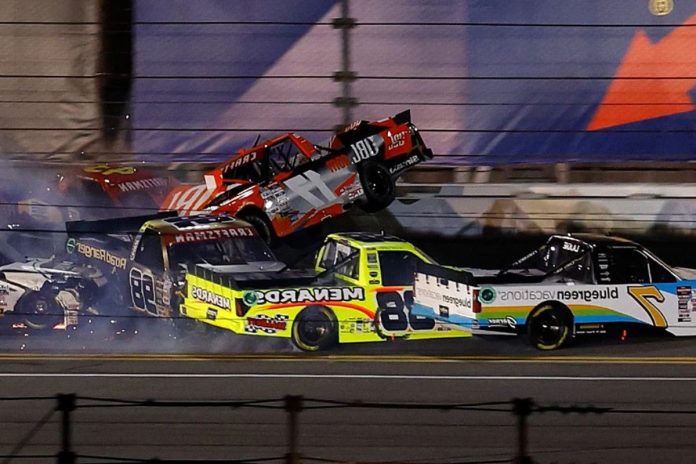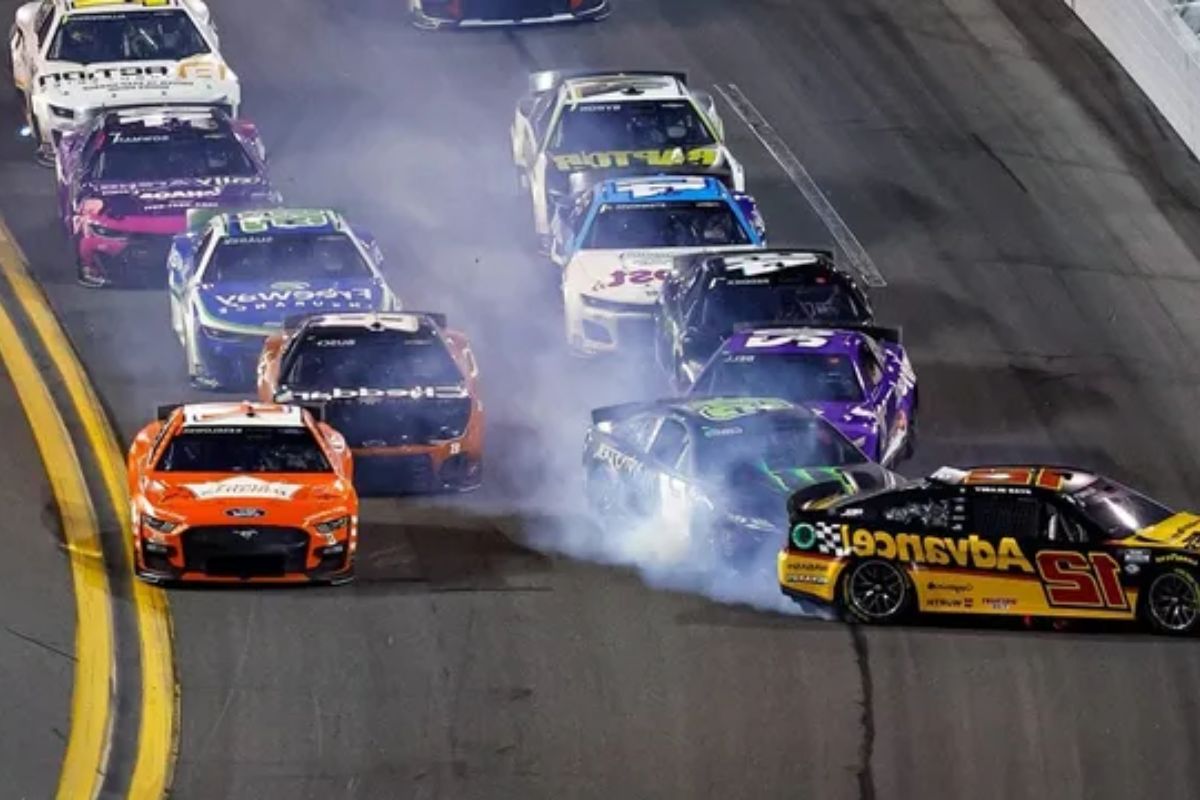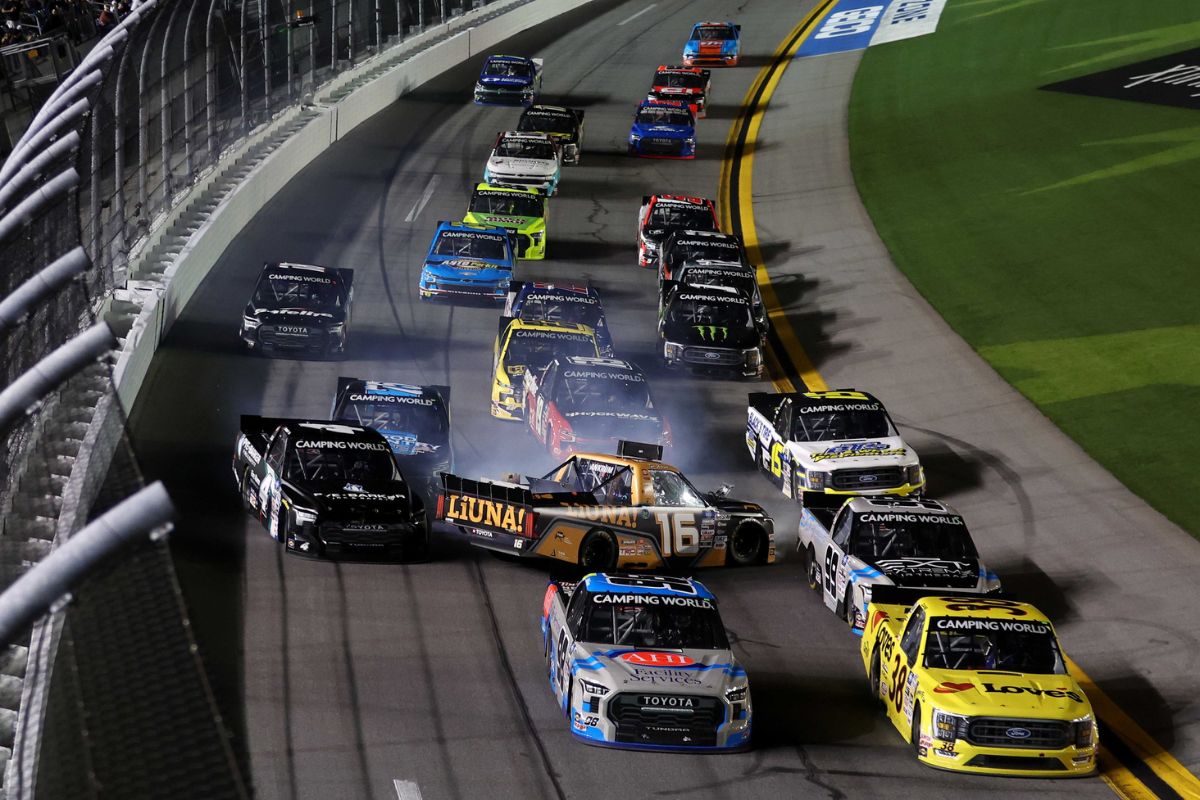Daytona Truck Race Chaos: The recent tumultuous events at the Daytona truck race have left fans clamoring for clarity amidst the chaos that ensued. As the dust settles on the record-setting mayhem witnessed on the track, questions linger about the sequence of events that transpired.
With calls for accountability echoing through the stands, it becomes imperative to dissect the root causes of the pandemonium that unfolded. Stay tuned as we unravel the layers of this perplexing situation and explore the demands for answers that have emerged from fans and stakeholders alike.
Key Takeaways
- Stern warnings failed to deter chaos.
- Rookies struggled in intense, wreck-filled race.
- Lack of concrete prevention plans evident.
- Calls for decisive actions to restore sport’s integrity.
Introduction
In the wake of the tumultuous NASCAR Truck race at Daytona, fans are left grappling with a spectacle that resembled a demolition derby, prompting a closer examination of the quality of racing on display. The chaotic scenes, characterized by multi-car wrecks and unpredictability, have raised significant concerns within the racing community. Nick Sanchez’s victory, although noteworthy, has been somewhat overshadowed by the mayhem that unfolded on the track.
Notably, the involvement and commentary of Cup Series drivers have drawn attention to the dire situation that unfolded during the race. Their insights and observations add a layer of credibility to the growing scrutiny surrounding the events at Daytona. The echoes of similar chaotic incidents in the ARCA Series only serve to intensify the need for a thorough investigation into the factors contributing to the heightened level of competition and risk in these races.
As fans demand answers and seek clarity on the future of NASCAR Truck racing, it becomes imperative to delve deeper into the root causes of the recent chaos to ensure the safety and integrity of the sport moving forward.
Prevention Attempts and Warnings
Amidst the aftermath of the tumultuous NASCAR Truck race at Daytona and the subsequent demand for answers from fans, scrutiny shifts towards the effectiveness of the prevention attempts and warnings issued to drivers before the chaotic events unfolded on the track.
Efforts to avert the mayhem were evident, as Truck Series’ managing director Seth Kramlich issued stern warnings to drivers before the weekend commenced. However, these attempts seemed futile as chaos ultimately unfolded on the track.
Former Cup driver Ty Dillon provided insight into the situation, describing the race as ‘chaos’ and highlighting the lack of drafting during practice. Dillon also emphasized the challenges rookies face in learning the ropes of such intense races. Despite the warnings issued, even seasoned drivers like Dillon faced disappointment, pointing out the lack of concrete plans and strategies among Truck drivers.
The revelations from Dillon shed light on the complexities and uncertainties surrounding the prevention attempts and warnings that were meant to safeguard against the chaos that ensued.
Record-Setting Chaos at Daytona
The record-setting chaos witnessed during the Truck race at Daytona, characterized by an unprecedented number of cautions and wrecks, exposed the extreme challenges drivers faced on the track. The event, spanning 100 laps, saw a staggering 12 cautions, consuming nearly half of the race time under caution. The wrecks, particularly prominent on corner exits, shed light on the struggle drivers had with truck looseness, emphasizing the demanding conditions of the race. Seasoned drivers like Corey LaJoie exhibited extreme aggression, contributing to multiple wrecks throughout the race. The final accident, which heavily impacted Taylor Gray, served as a poignant reminder of the perilous nature of the event.
Key Points:
- 12 cautions occurred during the 100-lap Truck race at Daytona.
- The wrecks were predominantly observed on corner exits, showcasing the challenge of truck looseness.
- Seasoned drivers, including Corey LaJoie, displayed aggressive driving leading to multiple wrecks.
- Taylor Gray was significantly affected by the final accident, highlighting the intensity of the challenges faced by drivers.
Deja Vu: Similar Incidents in Truck Series History
Drawing parallels with past events in the Truck Series, the recent chaotic race at Daytona echoes a troubling trend of on-track incidents that have raised concerns among drivers and fans alike.
Last year’s finale stands out as a prime example, where scenes similar to those witnessed at Daytona unfolded, eliciting strong criticism from Cup Series drivers. Martin Truex Jr voiced his dissatisfaction, labeling the racing as unprofessional, while Denny Hamlin expressed worries about the impact on viewership.
Notably, Kyle Busch, a former Truck Series team owner, highlighted a pervasive lack of respect among drivers, leading to increased car damage and overall chaos on the track.
These recurrent struggles within the Truck Series not only call into question the current state of professional auto racing but also prompt concerns about the direction in which the sport is heading.
The need for a thorough examination of these incidents and their underlying causes is becoming increasingly urgent to ensure the future sustainability and integrity of Truck Series racing.
Reflections on Chaos and Criticisms
Reflections on the chaos and criticisms surrounding recent Truck Series events reveal a troubling pattern of unprofessional behavior and lack of respect on the track.
- Lack of Professionalism: The dissatisfaction expressed by Cup Series drivers, past team owners, and experienced racers highlights a concerning lack of professionalism that undermines the integrity of the sport.
- Impact on Image: The critical comments from prominent figures in the racing community raise valid concerns about the long-term impact on the sport’s image and viewership, potentially alienating fans and sponsors.
- Need for Reforms: As the NASCAR Truck Series grapples with these challenges, there is a clear need for decisive actions and reforms to address the underlying issues and restore confidence in the sport.
- Ensuring Integrity: It is crucial for the stakeholders to collaborate and implement measures that prioritize the integrity and excitement of professional auto racing, safeguarding its future relevance and sustainability.
Conclusion Of Daytona Truck Race Chaos
The chaos at the Daytona truck race has left fans demanding answers. Despite prevention attempts and warnings, the record-setting chaos unfolded, sparking reflections on past incidents in the Truck Series.
The need for improved safety measures and event organization is evident, as criticisms mount. This incident serves as a stark reminder of the importance of thorough planning and execution in high-stakes events to ensure the safety and satisfaction of all involved.
Our Reader’s Queries
Q. How many miles is the Daytona truck race?
A. Originally scheduled for a 1:30 p.m. green flag on Saturday, the eagerly anticipated race spanning 200 miles, with notable contender Shane van Gisbergen in the mix, is undergoing a strategic shift. Instead, the action-packed event is rescheduled to take place following the culmination of Friday night’s Craftsman Truck Series opener, the Fresh From Florida 250. This adjustment adds an intriguing twist to the racing weekend’s lineup, creating an anticipatory buzz among fans and competitors alike.
Q. What time is the truck race at Daytona?
A. Under the Daytona night sky, the excitement unfolds as the Fresh From Florida 250 gears up for a thrilling kickoff at 7:30 p.m. on Friday, February 16, at the iconic Daytona International Speedway. The stage is set for a high-octane showdown under the Friday night lights, promising racing enthusiasts a spectacle to remember.
Q. Who won last night’s truck race?
A. In a record-breaking turn of events, the twelfth yellow flag unfurled, unfurling its cautionary tale as a violent and massive crash erupted on the backstretch. Amidst the chaos, Nick Sanchez emerged victorious, securing his inaugural Craftsman Truck Series win. This dramatic culmination marked the end of a relentless wreck-fest, etching a memorable chapter in the annals of the Fresh From Florida 250 at the iconic Daytona International Speedway on Friday night.
Q. How fast do truck racers go?
A. Unfolding its roots in the heart of the United States, the sport made its debut at the Atlanta Motor Speedway on a momentous day, June 17, 1979, leaving an indelible mark. Notably, it even graced the silver screen as the opening scene in the cinematic classic, Smokey and the Bandit II. Adding a layer of safety to the adrenaline-fueled races, a maximum speed cap of 160 km/h (100 mph) is enforced. Furthermore, there’s a steadfast minimum weight limit of 5500 kg, ensuring a balance between speed and stability on the racing canvas.
ALSO READ: NASCAR Opener Postponed: Daytona 500 to Roll on Monday





